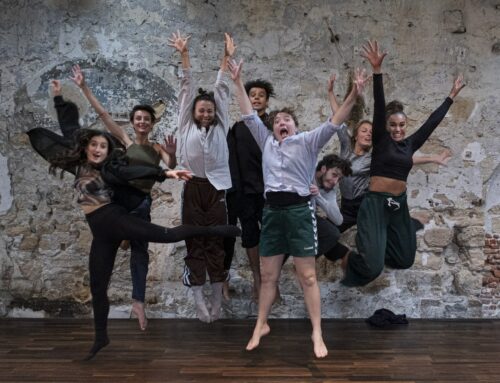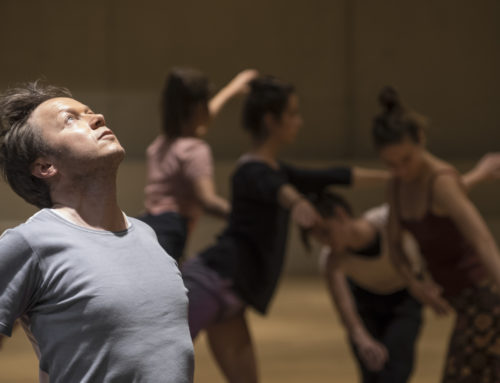An Artist’s portfolio… is like the window display of your choreography. It showcases your work and sense of self. It should resemble a window at Macy’s in the sense that at first glance, it pulls in its viewers and invites them to discover the designer’s style and creative intentions. In this article, you can pick from various layouts and rubrics to use for your portfolio. Obviously, take these suggestions with a grain of salt because your portfolio must reflect your own individuality, art and creation. So keep in mind, one uniform layout does not exist, but these tips may help you refine your collection.

Photo : Vadim Fomenok sur Unsplash
To start, like any professional presentation, your art portfolio should be flawless in terms of grammatical errors. So beware of spelling, syntax, and phrasing. Re-read your statements and paragraphs to catch all of your mistakes and make sure your sentences are in a logical order. Simplify your sentences that are too wordy, complex, or long. Sometimes it helps to read out loud your written work to check the flow of your text. You want a fluid document that makes it easier for the reader to understand your artistic work.
What rubric should I use to construct my portfolio? And why?
To open your art portfolio, you should have a cover page that clearly states the name of your piece, the title of the artistic direction (choreographer, co-director, stage manager) and the name of your company. On this page, it is equally important to put down all of the practical information: number of dancers (solo, duet, small group), length of the piece, year of creation, and date of premiere night. Providing this information on your cover page gives readers context and makes the initial reception much more comprehensive and favorable in relation to the rest of your work.
The second part is your core presentation which should have three main points: artist statement, synopsis of the work, and the project’s goals. Here you can talk about creating your piece. It is important to the reader to understand your opinions and what your intentions were for the piece as a whole. If it helps to clarify, you can link videos, teasers, and other clips featuring your piece at the end.
The third part of your art portfolio concerns the company and team presentation. Take the time to work on describing your company or collective group well. Think about how your spirit flows through your art and what ignited a flame in previous projects that led you to create this piece. What is the common thread woven from your past and present pieces and what themes remained the same? This will help us understand how you came to make your artistic decisions. By retracing your steps and themes in past creations, you can guide us along the spark that ignited your passion. After the company presentation, you should also take the time and give some biographical details about yourself as the choreographer(s). In this biography you should mention specifics of your path: dance education, technical training, company creation, and awards. These parts could be complemented with citations from the choreographer or a member of your team to highlight aspects of your portfolio. These quotes can be a way to cite in first person, but remember that the rest of your portfolio should be in third person to avoid personalization. To end this part of the presentation, you should also present the other artists who worked on the piece – musicians, performers, actors, designers – as well as the technicians of your crew.
The fourth part of your portfolio makes readers aware of your piece’s evolution. This should be clear by attaching a schedule of the planning involved (broadcast if the piece is completed and offered for sale). It is also in your best interests to show completed tasks with the names of your partners of what you have already done on the schedule to keep a record.
You cannot finish this portfolio unless you have mentioned the administrative information of your company (license number, SIRET, etc.) and if you have it available to you, do not forget to attach a technical sheet of your piece to the appendix, specifically if your piece required any installation procedure: video projector, screen, etc.).
How do you clearly state your note of intention? What do you say and in what form?
The artist’s statement allows you to define the subject, theme and intention of your creation. It is necessary that based on your writing, you take the time to find the best vocabulary for your description. The words you pick must fit your style well and allow readers to get a strong sense of your piece emotionally and visually. It might be helpful to have someone in your crew read over your artist statement and see if they understand your message at the level that you hope the general audience can get. Find someone, pretty neutral, and ask them what they thought the main message was based on your statement. The Artist statement allows you to craft your esthetic: genre of dance, type of space, staging, costumes, music and type of body. It is here that you explain your esthetic choices like the reason you chose to have all dancers wear black hats or how the presence of the musicians on stage was purposeful. To note, if you used outside sources in your artist statement – texts, poetry, painting, visual arts, music – make sure you cite these sources.
Common Mistakes to Avoid
Going back to our first point, your portfolio should not have any grammar mistakes. The first mistake you might make regarding editing your portfolio, might be not having another perspective. Taking a step outside of your circle, it can be incredibly helpful to have someone else take a look to read for awkward phrases or things that simply don’t make sense. This person should read your portfolio as if they had a magnifying glass over every detail. Do not hesitate to ask and encourage them to give you as much constructive feedback as possible. If it is missing clarity because phrases are too wordy or there is too little depth, you should want to know. That way, you can fix the problems before they are exposed to the public. It is more important to let some information go and to prioritize a clear message that you want readers to come away with rather than to flood the reader with every single detail.
Another common error is not taking enough time on the esthetic aspect of your portfolio. It is an art portfolio that should not be consumed by the word content or the specific layout. You should make sure it looks formal, but creative and admirable. Remember, you want to attract your viewers. So ensure that you are using high quality photos, strong visual cues and other artistic manners to display your work and train of thought. You should pick your photos based on the nature of your style and, of course, on your intentions. If you are not a graphic designer, there are easy online tools that can help you design your portfolio such as canva.



